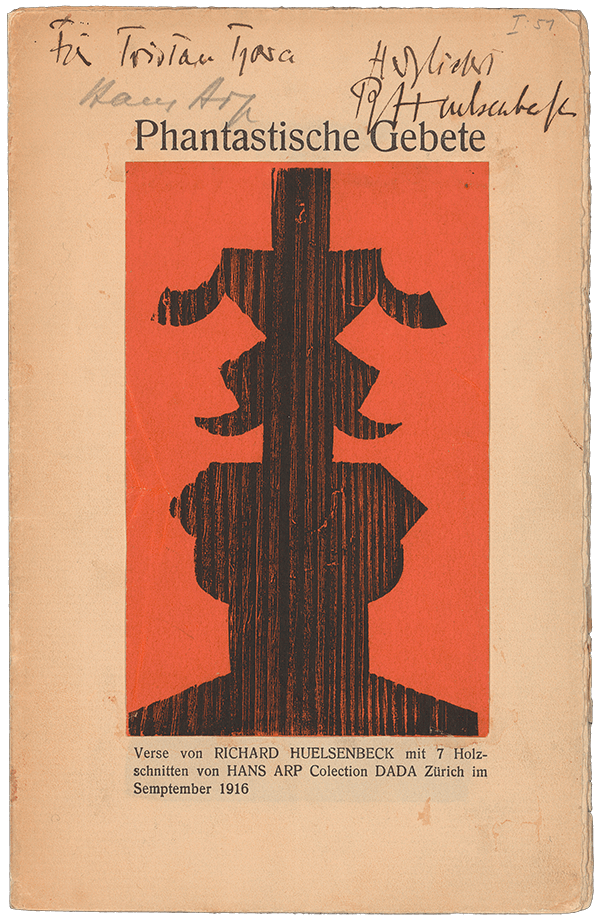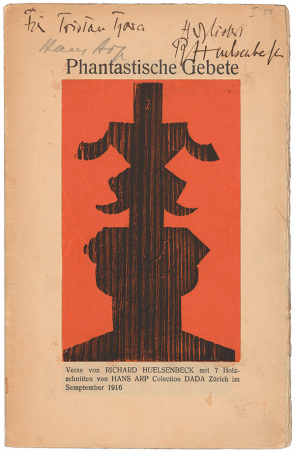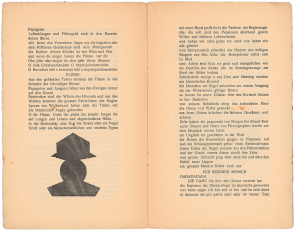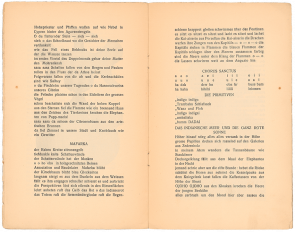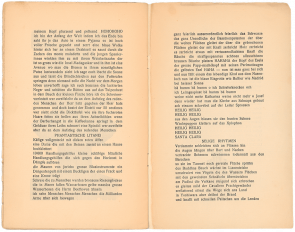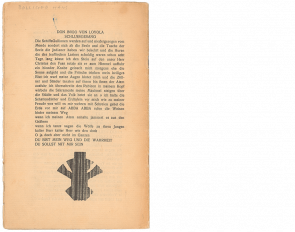After the Cabaret Voltaire had been closed down, the Dadaists continued their effective collaboration with the publication of their Collection Dada. This bibliophilic series of small illustrated volumes with poems and texts was published from July 1916 on, initially in a monthly rhythm, later in loose sequence and beyond Dada Zurich. Phantastische Gebete assembles a number of texts which Richard Huelsenbeck had presented in the Cabaret Voltaire and at the first Dada soirée in the Zunfthaus zur Waag. When on stage, Huelsenbeck sought the confrontation with the public, acted aggressively, provocatively, ecstatically, with a rosewood stick in his hand and a kettledrum at his side. His performances always caused a stir—laying it on thick, Tristan Tzara even described them as ending in veritable tumults in his Chronique zurichoise: “on apporte la grosse caisse, Huelsenbeck contre 200, Ho-osenlatz accentué par la très grosse caisse et les grelots au pied gauche—on proteste on cire on casse les vitres on se tue on démolit on se bat la police interruption” (the bass drum is brought in, Huelsenbeck against 200, the fly of his trou-trousers accentuated by the big bass drum and the little bells on his left foot—there’s protest there’s flattery windows being smashed people killing each other demolishing the place battering each other the police interruption). Like no one else, Huelsenbeck preferred frontal attacks relying on blasphemy and literary parody, elevating prayer into the realm of fantasy. The frequent doubling of sounds, syllables, and words (“es schliesset der Pfarrer den Ho-osenlatz rataplan rataplan den Ho-osenlatz und das Haar steht ihm au-aus den Ohren” [the priest closeth the fly of his trou-trousers rataplan rataplan the fly of his trou-trousers and tufts of hair protrude fro-om his ears]) are tailored to the “Dada drummer” Huelsenbeck, who strove for an archaic relationship to reality in his “negro rhythms.”
Three publications in the series Collection Dada forthcoming in Zurich comprised works by Hans Arp, each of his contributions of a different kind: the figurative drawings in Schalaben schalabai schalamezomai were followed by the symmetrical, well-balanced woodcuts of Phantastische Gebete, which turned into moving biomorphic forms in Vingt-cinq Poèmes. The symmetrical woodcuts which also illustrate Dada 1, program leaflets, and Dada printed matter around 1916/1917 are the expression of a radical personal order that was to “create a balance between heaven and hell” (Hans Arp). Without any references to preceding avant-garde movements and in rejection of oil painting, naturalism, and mimesis Arp created a completely original world of signs within the elementary symmetry of his woodcuts. A second, enlarged edition of Phantastische Gebete with illustrations by George Grosz was published in the years of Dada Berlin in 1920.
Edition: According to later statements by Huelsenbeck “certainly not more than 500 copies” were printed. Price: 3 CHF. Deckle-edged paper. Title woodcut on red paper (14.7 × 9.2 cm) mounted on the title page between the printed text. Title page with the artist’s dedication in ink: “Für Tristan Tzara Herzlichst R Huelsenbeck” (For Tristan Tzara Cordially R Huelsenbeck), signed in pencil: “Hans Arp.” There is a variant edition of these poems with a different title woodcut printed directly on the cover. Provenance: Hans Bolliger, Zurich, 1984.
→ Hans Arp, Prä-Dada-Zeichnung [pre-Dada drawing], Z.Inv. 1990/58
→ Sophie Taeuber and Hans Arp with puppets for König Hirsch [King Stag], DADA VI:1
→ Cabaret Voltaire, DADA III:37
